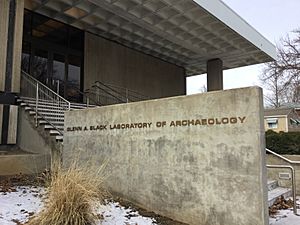Glenn A. Black Laboratory of Archaeology facts for kids
 |
|
| Established | 1971 |
|---|---|
| Location | 423 N. Fess Avenue Indiana University, Bloomington, Indiana |
| Type | Archaeology |
The Glenn A. Black Laboratory of Archaeology (GBL) was a special place in Bloomington, Indiana. It was a center for studying archaeology and also a museum. Archaeology is the study of human history and prehistory through digging up old sites and objects.
In 2020, the GBL joined with another museum, the Mathers Museum of World Cultures. Together, they became the new Indiana University Museum of Archaeology and Anthropology. The GBL was named after Glenn A. Black, who was Indiana's very first professional archaeologist. He spent his life studying the ancient people who lived at a place called Angel Mounds. This important site is still being studied by archaeologists today.
Contents
History of the GBL
The Glenn A. Black Laboratory of Archaeology officially opened on April 21, 1971. A close friend of Glenn A. Black, a man named Eli Lilly, asked for the museum to be created. He also gave money to help the GBL get started and keep going.
Amazing Collections
The Glenn A. Black Laboratory of Archaeology held many interesting items. Its collections came from all over Indiana. They also included materials from 38 other states in the U.S. Plus, there were items from at least 11 other countries around the world!
What Are Archaeological Collections?
The archaeological collections at the GBL were huge, with over 5 million individual objects. These items included cultural artifacts, which are things made or used by people long ago. Some were found during digs, and others were donated.
The collections also had natural and geological items. These came from many different sites in the Midwest, including the famous Angel Mounds. The GBL also had special teaching collections. These were used by schools and tour groups to learn about archaeology.
Ethnohistory Collections: Stories of the Past
The Great Lakes and Ohio Valley Ethnohistory Collection is a special part of the GBL's archives. It holds materials put together by a researcher named Erminie Wheeler-Voegelin. These materials tell the history of different groups and tribes in the Ohio Valley and Great Lakes region. They cover a long period, from the 1600s up to the late 1900s.
This collection also includes information gathered by the Indian Claims Commissions (ICC). These commissions looked into land use and history for Native American groups. This collection is very large and helpful for researchers.
=Images for kids
The Glenn A. Black Laboratory of Archaeology had a huge collection of images and films. It included over 12,000 photographs and 9,000 negatives. There were also 8,200 slides and 50 old glass plate images. Plus, it had 100 film reels from the 1920s.
These pictures and films show the history of archaeological work in the Midwest. You can see famous archaeologists like Eli Lilly, Warren K. Moorehead, and Glenn A. Black in these historical records.
Library and Archives: Research Resources
The GBL also had a library and archives. These were places where people could come and do research. You could only use these materials at the GBL itself.
The James H. Kellar Library
The James H. Kellar Library was filled with books and other resources for study. It had reports from archaeological digs and maps of specific sites in Indiana. You could also find documents about the history of the Glenn Black Laboratory. Many other books about archaeology were available there too.
The Erminie Wheeler-Voegelin Archives
These archives held many important papers and records, including:
- The Great Lakes-Ohio Valley Ethnohistory Collection
- Eli Lilly Archaeology Papers
- Glenn A. Black Papers
- James H. Kellar Papers
- Jack C. Householder Papers
- Noel D. Justice Papers
- Christopher S. Peebles Papers
- Warren K. Moorehead Papers
- Edward V. McMichael Papers
- Douglas S. Byers Papers
- Clifford Anderson Papers
- George K. Neuman Papers
- Sherri Hilgeman Papers
- Midwest Archaeological Conference Records
- Cheryl Munson Papers
- Glenn A. Black Laboratory of Archaeology Institutional Records
GBL Fieldwork Archives
The GBL's Fieldwork Archives kept maps, field books, and information from archaeological digs. It included documents about the Angel Mounds site from 1939 to 1965. There were also records from other projects, GBL field schools, and donations. Information about state and federal collections and records for the Indiana Historical Society were also stored here.
Midwest Lithic Repository
The GBL had a special collection called the Lithic Raw Material Repository. "Lithic" means related to stone. This collection was built to help people understand different types of stone materials. It had over 500 samples of stones gathered from North America, especially the Northwest region. Archaeologists, museums, and even the government could use this collection. It helped them identify different types of stones and create collections for study.

